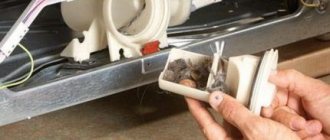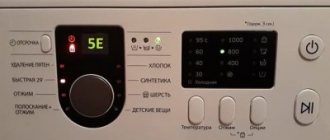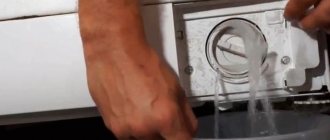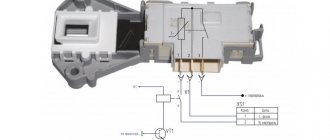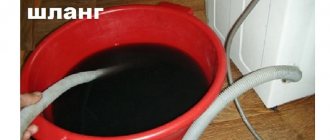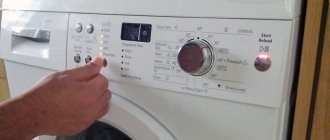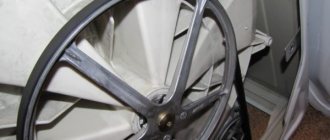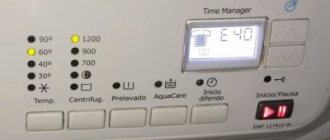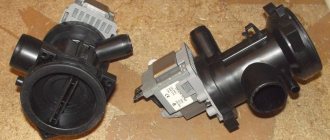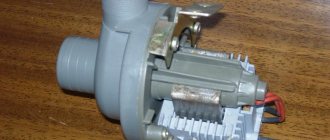What role does it play?
Frequent relay switching, starting and stopping the asynchronous motor inside the machine itself, in turn, cause constant changes in currents that cannot be passed into the external electrical network so as not to damage other electrical equipment connected to it (TVs, computers, microwave ovens, etc.) This the device detects these differences and “dumps” excess currents to ground. The washing machine surge protector protects from voltage surges not so much the machine itself as the external electrical network from it.
A strong voltage drop in the network can lead to the combustion of an asynchronous motor, because it stops rotating, and current continues to flow into its winding. In this case, this protective device immediately turns off the washing machine. If the voltage drop is short-lived, the filter uses the charge of its capacitors to maintain normal operation of the machine. That is why it is not recommended to operate the washing machine without it.
In the event of a breakdown, the surge protector can only be replaced as a whole assembly, since its parts are filled with a special waterproof compound that does not allow current to pass through.
These are fairly reliable devices and they rarely break, but sometimes it happens. Most often this occurs due to a decrease in the capacitance of the capacitors inside the filter over time. Less often - due to a strong voltage surge, which can cause a breakdown.
Under no circumstances should you turn off a running washing machine by unplugging it from the socket - this can also damage the filter!
You can get and replace the interference filter yourself or with the help of a specialist, but how can you tell if it’s broken?
Purpose of a surge protector
A surge protector for a washing machine will do the job perfectly . It will protect against surges and voltage drops in the network, muffling impulse and high-frequency interference.
A surge protector is not just an extension cord with a certain number of sockets and a fuse.
The filter can be built into the equipment at the production stage or purchased as an additional protection part and connected to the device via a power source.
Built-in surge protector
Modern washing equipment is a rather complex device, but nevertheless sensitive, for example, to current changes in the network.
Therefore, it requires reliable protection and stability in the first place, because otherwise a washing machine without a surge protector, receiving high or low impulses, may burn out.
Especially if it is an automatic machine with touch controls. We take into account the fact that such models are sensitive; the manufacturer himself supplies the machine with a surge protector during the production process. It is located where the electrical cord begins. If it breaks, the internal filter cannot be repaired but must be replaced. The part is replaced with an original spare part, which is not always easy to do.
Internal filters vary in degree of protection depending on the manufacturer and model of the connected equipment. The level of protection is related to:
- maximum load and maximum current;
- passable voltage threshold;
- rated current;
- response time after a power surge to shutdown.
External surge protector
Such a device can protect equipment from short circuits and current surges, thanks to a fuse, cutting off the flow of electricity.
Manufacturers offer extension cords with different numbers of sockets and types of protection :
Some models are improved with additional devices in the form of an on or off button on each outlet or have child protection .
A large number of sockets on an extension filter is important when there are several devices standing nearby. This filter is quite powerful, but also more expensive.
The difference may be in the length of the extension cord . You need to pay attention to this when purchasing and calculate the required length in advance.
Maximum load is an important indicator.
If we take professional protection, then the rate of energy surges absorbed by the filter is 2500 J, while for a simple one this figure is 960 J.
The filter may contain several fuses , but one of them must be fusible, and the rest are divided into high-speed and thermal.
Some manufacturers provide the protective mechanism with an LED indicator , which allows you to visually assess the performance of the device.
What cannot be done when using protection with an external surge protector?
- The device operating through the filter should not have a power exceeding 3.5 kW.
- You cannot connect an extension cord to a 380 V network.
- Connecting such devices at the same time is dangerous.
- A prerequisite when using a filter is to ground the outlet.
Troubleshooting
Most modern washing machines are designed in such a way that if the interference filter fails, they automatically stop working and do not start until the broken part is replaced. Therefore, the very first evidence of a breakdown is the inability to turn on the machine. Of course, this can be caused by other problems, the simplest of which is damage to the power cord or its plug. But if everything is in order with them, then the noise filter is next in line.
Also, if the machine suddenly began to electrocute, there was a smell of burnt insulation, or the machine spontaneously began to change operating modes during washing (regardless of the program you chose), all this also indicates a malfunction of the surge protector.
If you have a multimeter (a device for measuring resistance, voltage and current), then in this situation you should use it so as not to call a technician:
- First of all, you need to call all contacts in pairs. The resistance should be about 680 kOhm.
- Next, measure the input resistance at the plug. The resistance should also be around 680k ohms, although it may vary slightly.
- It is quite difficult to check the condition of the capacitors due to the fact that they are filled with compound. But you can try to measure the capacitance between different inputs. Its value should be about 0.47 µF.
If, when ringing the contacts, you notice that the resistance is infinity or the capacity tends to zero, then the device is damaged and needs to be replaced.
Surge filter for an automatic machine: what is it and why is it needed?
In order to avoid paying for expensive repairs, you can take care of proper protection of your automatic washing machine in advance. A surge protector for a washing machine comes to the rescue. Network filter:
- perfectly smooths out any voltage fluctuations;
- saves equipment from breakdown due to power surges and sudden drops;
- ensures a normal washing process, without any interference;
- protects household appliances adjacent to the washing machine from high frequency currents that can enter the electrical network during operation of the washing machine.
But you should not mistake an extension cord that has several outlets for such a protective filter. The extension cord can be used for all household appliances in general, and the surge protector takes on the protective functions of the complex system of the automatic washing machine and other household appliances surrounding it. Surge filters can be built into the machine at the factory, or can be purchased separately by the consumer to connect the washing machine machine through it to the power source. The built-in network filter is a housing made of impact-resistant material that does not conduct current. All parts are protected by a non-conductive liquid poured into the body. Modern washing machines are very complex systems that require reliable protection and an even and stable power supply. If the component equipment receives high or, conversely, low impulses, it burns out and requires replacement. This is especially true for machines with touch controls; they are very sensitive to even the slightest voltage drops. Therefore, surge protectors are installed on such devices by the manufacturer. As a rule, it is located where the electrical cord exits. See also -
How to replace the water supply hose for a washing machine
Indicator - informs that the surge protector is turned on, often combined with the switch button. Depending on the model, it can be common or individual for each surge protector outlet.
Criterias of choice
You can find a new surge protector of the desired brand anywhere: in a household appliance store, in an online store or from an official supplier. If you cannot find a “native” one, it can be replaced with one with similar electrical characteristics.
In this case, first of all, you need to pay attention to the maximum pulse overload current and the maximum current consumption, the value of which should be 2-3 times higher than that of the washing machine (calculated from the power).
You can also temporarily replace a broken filter with an external auxiliary filter, which itself is connected to the mains through an outlet, and all electrical appliances are connected to it.
Conclusion
Now you know a little about what can cause your washing machine to not work. And you won’t panic if this happens. Remember that surge protectors rarely fail without reason. This requires a serious external overload of the electrical network, exceeding the protection capabilities (lightning strike, welding machine on the same line, etc.).
But if the washing machine has served you faithfully for a long time, then over time the surge protector may break on its own - from old age.
Protecting your washing machine with a filter
Modern models of washing machines contain a large number of electronic elements and parts inside. They require a stable, even power supply to function. If electronic components receive voltage with a higher pulse, they will burn out and fail. Voltage surges will be especially harmful for:
- a central processor that controls the operation of all parts of the machine;
- touch panel with which user control is performed;
- an asynchronous electric motor driving the washing drum;
- a tubular electric heater (TEH) that heats water.
Manufacturers of complex household appliances provide a built-in surge protector to protect electronic components from power surges. The filter parts are placed in a shock-resistant housing, which is filled with a dielectric mixture. Everything is done hermetically to prevent water from getting inside the device. Such protective measures make it impossible to repair the filter, so if it fails, you only have to replace it.
If there were no internal surge filter, then even a small voltage surge arriving at the central processor would lead to a breakdown of the washing machine. The filter protects not only from surges, but also from voltage drops, which can also damage the machine. The electric motor installed in the washing machine operates in a small voltage range.
If the network voltage is low, the washing machine motor will not have enough power to spin the drum. However, electricity will continue to flow to it, which will lead to overheating and the engine will burn out. When the voltage drops, the FPS will stop supplying electricity to the device, thereby protecting it.
A surge protector installed in a washing machine protects not only it, but also other household appliances connected to the power supply. The fact is that the operation of an asynchronous motor is accompanied by the appearance of high frequency currents. If they get into the electrical network, they can harm other devices. This is also one of the reasons for installing surge protectors on modern machine models.
